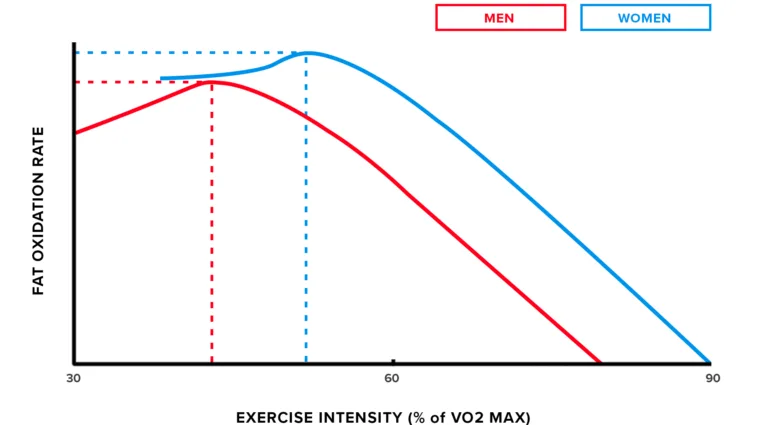Topics
- Article
- International
- Women’s Performance
Sports Nutrition for Women & How the Menstrual Cycle Impacts It

Dr. Hazel Wallace discusses different fueling needs for women compared to men and how they may be affected by phases of the menstrual cycle.
Compared to men, do women have different needs when it comes to fueling for sport and exercise?
Burning Fat vs. Carbohydrates
Carbohydrates and fat are the key energy sources used during exercise. Protein cannot be stored so it is not an official energy reserve, but it can be used for fuel in certain situations. As exercise intensity increases, carbohydrate (mostly from glycogen stores in the muscle) contributes the most energy, whereas fat is a more important fuel at lower intensity exercise. This holds true for both sexes. However, compared to men, women tend to burn more fat for fuel at the same relative intensity of activity. In other words, women rely on carbohydrates less and burn fat more for fuel than men do at a higher intensity (1-5). Theoretically, if women burn more fat, and spare the smaller (more precious) glycogen stores in the muscle, this would prevent them “hitting the wall,” allowing them to keep going for longer, and therefore, make them more suitable for endurance sports.

Burning more fat during exercise Than men allows for women to potentially have greater success in endurance sports (graph adapted from mysportscience.com/Venables et al., 2005).
Women’s Bodies & Endurance Sports
In practice, men still outperform women in endurance sports and events. What is interesting though is that this gender difference may be as low as 4% in ultra-marathons (which are > 100 miles in length) and basically negligible in ultra-cycling events (which are > 400-500 miles) (6,7). Furthermore, females generally outperform males in long-distance open-water swimming (> 30 km)(8,9). The unique sex-specific factors that seem to give females an edge in ultra-endurance sport is not just down to fuel selection, but also different muscle fibre make up and fatiguability, lower energy requirements, and amount and distribution of body fat (better for buoyancy in ultra-distance swimming). The difference in fuel selection between the sexes is thought to be largely mediated by estrogen, which brings us to the next question--is there a difference in fuel selection across the menstrual cycle? The short answer is yes. The caveat is… it’s complicated.

Hormone levels change during varying phases of the menstrual cycle.
Fueling Needs & Menstrual Cycle Phases
In the luteal phase (second half of the cycle), research shows that women rely less on carbohydrate for fuel (compared to in the follicular phase) during moderate-intensity endurance exercise (4,10). In addition to burning more fat for fuel in the luteal phase, there is also increased use and breakdown of protein, which also comes with increased metabolic rate during this time (11-13). The body is smart, and to account for this we also see increased hunger, cravings and food intake, particularly in the late luteal phase (14). Here comes the caveat--findings are very conflicting and most studies have only seen minor differences, with others having found no difference in fuel selection across the menstrual cycle (4, 10, 15-17). These differences in findings are likely due to exercise intensity (which is the primary determinant of what fuel we use during exercise) and individual differences between women in response to hormonal fluctuations across the cycle (17).
Practical Recommendations for Nutrition Based on Menstrual Cycle
Research in this field is in its infancy (and conflicting) so we don’t have enough evidence yet to start making blanket recommendations for nutrition across the menstrual cycle. So, the advice provided here should be used as a guide and not the rule. Nutritional recommendations will also vary from person to person and are dependent on your goals (e.g. strength or weight loss).
Follicular phase
Specific nutrition recommendations are less important during this phase. However, menstruation (early follicular phase) is an inflammatory process in and of itself, so during this time you might be more vulnerable to infection and take longer to recover. Make sure you’re getting enough rest, adequate sleep, hydration and good nutrition (now is the time to amp up your colorful fruit and veg!) (18).
Luteal phase
Due to increased energy expenditure during this time and preference for fat over carbohydrates for fuel, ensure you’re including plenty of healthy fat sources in the diet such as avocado, nut butter, nuts and seeds, and at least one portion of oily fish per week. There is also increased metabolism of amino acids during this phase, so increasing protein intake will help account for this while supporting strength adaptations and recovery. Protein is also satiating and can help with increased hunger and cravings that people usually experience in the late luteal phase. While your body may rely less on carbohydrates for fuel during this time, they’re still extremely important in the diet and will further support your training and recovery, regardless of the phase of your menstrual cycle. Opting for complex carbohydrates (whole grains, legumes, fruit and vegetables) over foods high in sugar (such as cakes, sweets, chocolate, ice-cream) may help control carbohydrate cravings and support mood and energy levels by stabilizing your blood glucose levels.
Key Takeaways
Females have unique nutritional requirements due to fluctuations in sex hormones, such as estrogen and progesterone, throughout the mensural cycle and lifecycle. Research in this field is lacking and conflicting. However, an absence of evidence is not evidence of absence and this is something all women can start to consider on an individual level--especially athletes who really want to squeeze out that extra 1%. Start by tracking your dietary habits across your cycle, noting things like nutrient intake, cravings, hunger levels, and energy levels. Also track your training, sleep, and recovery, which can easily be done using your WHOOP. In fact, WHOOP even has a new feature (called Menstrual Cycle Insights) which can make sleep and training recommendations based on where you are in your cycle. As you collect more data and insight into how your body changes and responds across the menstrual cycle, you will be able to make more informed nutrition and training decisions unique to you!
References
- Tarnopolsky LJ, MacDougall JD, Atkinson SA, Tarnopolsky MA, Sutton JR. Gender differences in substrate for endurance exercise. J Appl Physiol (1985). 1990 Jan;68(1):302-8. doi: 10.1152/jappl.1990.68.1.302. PMID: 2179207
- Tarnopolsky MA, Atkinson SA, Phillips SM, MacDougall JD. Carbohydrate loading and metabolism during exercise in men and women. J Appl Physiol (1985). 1995 Apr;78(4):1360-8. doi: 10.1152/jappl.1995.78.4.1360. PMID: 7615443.
- Carter SL, Rennie C, Tarnopolsky MA. Substrate utilization during endurance exercise in men and women after endurance training. Am J Physiol Endocrinol Metab. 2001 Jun;280(6):E898-907. doi: 10.1152/ajpendo.2001.280.6.E898. PMID: 11350771.
- Devries MC, Hamadeh MJ, Phillips SM, Tarnopolsky MA. Menstrual cycle phase and sex influence muscle glycogen utilization and glucose turnover during moderate-intensity endurance exercise. Am J Physiol Regul Integr Comp Physiol. 2006 Oct;291(4):R1120-8. doi: 10.1152/ajpregu.00700.2005. Epub 2006 May 11. PMID: 16690766.
- Venables MC, Achten J, Jeukendrup AE. Determinants of fat oxidation during exercise in healthy men and women: a cross-sectional study. J Appl Physiol (1985). 2005 Jan;98(1):160-7. doi: 10.1152/japplphysiol.00662.2003. Epub 2004 Aug 27. PMID: 15333616.
- Waldvogel KJ, Nikolaidis PT, Di Gangi S, Rosemann T, Knechtle B. Women Reduce the Performance Difference to Men with Increasing Age in Ultra-Marathon Running. Int J Environ Res Public Health. 2019;16(13):2377. Published 2019 Jul 4. doi:10.3390/ijerph16132377
- Baumgartner S, Sousa CV, Nikolaidis PT, Knechtle B. Can the Performance Gap between Women and Men be Reduced in Ultra-Cycling? Int J Environ Res Public Health. 2020 Apr 7;17(7):2521. doi: 10.3390/ijerph17072521. PMID: 32272640; PMCID: PMC7177769.
- Knechtle B, Rosemann T, Lepers R, Rüst CA. Women outperform men in ultradistance swimming: the Manhattan Island Marathon Swim from 1983 to 2013. Int J Sports Physiol Perform. 2014 Nov;9(6):913-24. doi: 10.1123/ijspp.2013-0375. PMID: 24584647.
- Knechtle B, Dalamitros AA, Barbosa TM, Sousa CV, Rosemann T, Nikolaidis PT. Sex Differences in Swimming Disciplines-Can Women Outperform Men in Swimming?. Int J Environ Res Public Health. 2020;17(10):3651. Published 2020 May 22. doi:10.3390/ijerph17103651
- Willett HN, Koltun KJ, Hackney AC. Influence of Menstrual Cycle Estradiol-β-17 Fluctuations on Energy Substrate Utilization-Oxidation during Aerobic, Endurance Exercise. Int J Environ Res Public Health. 2021 Jul 5;18(13):7209. doi: 10.3390/ijerph18137209. PMID: 34281146; PMCID: PMC8295741.
- Tiller NB, Elliott-Sale KJ, Knechtle B, Wilson PB, Roberts JD, Millet GY. Do Sex Differences in Physiology Confer a Female Advantage in Ultra-Endurance Sport? Sports Med. 2021 May;51(5):895-915. doi: 10.1007/s40279-020-01417-2. Epub 2021 Jan 27. PMID: 33502701
- Lariviere, F.; Moussalli, R.; Garrel, D.R. Increased leucine flux and leucine oxidation during the luteal phase of the menstrual cycle in women.Am. J. Physiol.1994,267 (Pt 1), E422–E428.
- Sawai, A.; Tsuzuki, K.; Yamauchi, M.; Kimura, N.; Tsushima, T.; Sugiyama, K.; Tochikubo, O. The effects of estrogen and progesterone on plasma amino acids levels: Evidence from change plasma amino acids levels during the menstrual cycle in women.Biol. Rhythm Res.2020,51, 151–164
- Dye L, Blundell JE. Menstrual cycle and appetite control: implications for weight regulation. Hum Reprod. 1997 Jun;12(6):1142-51. doi: 10.1093/humrep/12.6.1142. PMID: 9221991.
- Zderic TW, Coggan AR, Ruby BC. Glucose kinetics and substrate oxidation during exercise in the follicular and luteal phases. J Appl Physiol (1985). 2001 Feb;90(2):447-53. doi: 10.1152/jappl.2001.90.2.447. PMID: 11160041.
- Frandsen J, Pistoljevic N, Quesada JP, Amaro-Gahete FJ, Ritz C, Larsen S, Dela F, Helge JW. Menstrual cycle phase does not affect whole body peak fat oxidation rate during a graded exercise test. J Appl Physiol (1985). 2020 Mar 1;128(3):681-687. doi: 10.1152/japplphysiol.00774.2019. Epub 2020 Feb 20. PMID: 32078462.
- Boisseau N, Isacco L. Substrate metabolism during exercise: sexual dimorphism and women's specificities. Eur J Sport Sci. 2021 Jun 17:1-21. doi: 10.1080/17461391.2021.1943713. Epub ahead of print. PMID: 34134602.
- Evans J, Salamonsen LA. Inflammation, leukocytes and menstruation. Rev Endocr Metab Disord. 2012 Dec;13(4):277-88. doi: 10.1007/s11154-012-9223-7. PMID: 22865231.